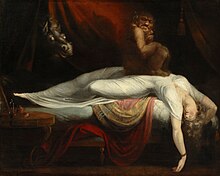| Nightmare disorder | |
|---|---|
 | |
| The Nightmare, by Johann Heinrich Füssli | |
| Specialty | Psychiatry |
| Frequency | c. 4%[1] |
Nightmare disorder is a sleep disorder characterized by repeated intense nightmares that most often center on threats to physical safety and security.[2] The nightmares usually occur during the REM stage of sleep, and the person who experiences the nightmares typically remembers them well upon waking.[2] More specifically, nightmare disorder is a type of parasomnia, a subset of sleep disorders categorized by abnormal movement or behavior or verbal actions during sleep or shortly before or after. Other parasomnias include sleepwalking, sleep terrors, bedwetting, and sleep paralysis.[3]
Nightmare disorders can be confused with sleep terror disorders.[4] The difference is that after a sleep terror episode, the patient wakes up with more dramatic symptoms than with a nightmare disorder, such as screaming and crying.[4] Furthermore, they do not remember the reason of the fear, while a patient with a nightmare disorder remembers every detail of the dream.[4] Finally, the sleep terrors usually occur during NREM Sleep.[5][6]
Nightmares also have to be distinguished from bad dreams, which are less emotionally intense.[7] Furthermore, nightmares contain more scenes of aggression than bad dreams and more unhappy endings.[7] Finally, people experiencing nightmares feel more fear than with bad dreams.[7]
The treatment depends on whether or not there is a comorbid PTSD diagnosis.[1] About 4% of American adults are affected.[1] Studies examining nightmare disorders have found that the prevalence rates ranges 2–6% with the prevalence being similar in the US, Canada, France, Iceland, Sweden, Belgium, Finland, Austria, Japan, and the Middle East.[8]
- ^ a b c Morgenthaler, Timothy I.; Auerbach, Sanford; Casey, Kenneth R.; Kristo, David; Maganti, Rama; Ramar, Kannan; Zak, Rochelle; Kartje, Rebecca (15 June 2018). "Position Paper for the Treatment of Nightmare Disorder in Adults: An American Academy of Sleep Medicine Position Paper". Journal of Clinical Sleep Medicine. 14 (6): 1041–1055. doi:10.5664/jcsm.7178. PMC 5991964. PMID 29852917.
- ^ a b Fariba, Kamron A.; Tadi, Prasanna (2023), "Parasomnias", StatPearls, Treasure Island (FL): StatPearls Publishing, PMID 32809359, retrieved 2023-03-24
- ^ Singh, Shantanu; Kaur, Harleen; Singh, Shivank; Khawaja, Imran (2018-12-31). "Parasomnias: A Comprehensive Review". Cureus. 10 (12): e3807. doi:10.7759/cureus.3807. ISSN 2168-8184. PMC 6402728. PMID 30868021.
- ^ a b c "Nightmare disorder". minddisorders.com.
- ^ Spoormaker, Victor I.; Schredl, Michael; Bout, Jan van den (2006-02-01). "Nightmares: from anxiety symptom to sleep disorder". Sleep Medicine Reviews. 10 (1): 19–31. doi:10.1016/j.smrv.2005.06.001. ISSN 1087-0792. PMID 16377217.
- ^ Hockenbury, Don H. (2011). Discovering psychology. Hockenbury, Sandra E. (5th ed.). New York, NY: Worth Publishers. p. 157. ISBN 978-1-4292-1650-0. OCLC 463639317.
- ^ a b c Zadra, Antonio; Robert, Geneviève (2014-02-01). "Thematic and Content Analysis of Idiopathic Nightmares and Bad Dreams". Sleep. 37 (2): 409–417. doi:10.5665/sleep.3426. ISSN 0161-8105. PMC 3900621. PMID 24497669.
- ^ Nadorff, Michael R.; Lambdin, Karen K.; Germain, Anne (2014-04-01). "Pharmacological and non-pharmacological treatments for nightmare disorder". International Review of Psychiatry. 26 (2): 225–236. doi:10.3109/09540261.2014.888989. ISSN 0954-0261. PMID 24892897. S2CID 7331480.